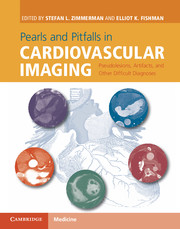 Pearls and Pitfalls in Cardiovascular Imaging
Pearls and Pitfalls in Cardiovascular Imaging from Section 8 - Post-operative aorta
Published online by Cambridge University Press: 05 June 2015
Imaging description
Prosthetic aortic grafts often have areas of kinking where there is in-folding of the graft wall into the aortic lumen. This is a normal post-operative finding that is generally of no clinical consequence. On axial images, vertically oriented folds will have the appearance of an intraluminal flap and can mimic dissection (Figures 70.1 and 70.2). Inspection of sagittal and coronal planes and volume-rendered images will allow visualization of the kinked segment and exclusion of dissection.
Importance
It is important to avoid misdiagnosis of aortic dissection as it may lead to unnecessary surgery or repeat imaging.
Typical clinical scenario
Kinking in the aortic graft is common in patients with prior open graft repair of the thoracic or abdominal aorta.
Differential diagnosis
Aortic graft kinking should be distinguished from a true aortic dissection. Careful inspection of multiplanar and 3D reformatted images should allow visualization of the kinking and prevent misdiagnosis. The location of abnormality can also be helpful as dissections do not occur within prosthetic aortic graft material. Dissections may, however, occur in the native aorta immediately adjacent to an anastomosis.
Teaching point
Kinking of aortic grafts after open aortic repair is common and can result in linear intraluminal filling defects that mimic dissection on axial images. The use of multiplanar reformatted and volume-rendered images will allow visualization of the kinked segment and help avoid misdiagnosis.
To save this book to your Kindle, first ensure no-reply@cambridge.org is added to your Approved Personal Document E-mail List under your Personal Document Settings on the Manage Your Content and Devices page of your Amazon account. Then enter the ‘name’ part of your Kindle email address below. Find out more about saving to your Kindle.
Note you can select to save to either the @free.kindle.com or @kindle.com variations. ‘@free.kindle.com’ emails are free but can only be saved to your device when it is connected to wi-fi. ‘@kindle.com’ emails can be delivered even when you are not connected to wi-fi, but note that service fees apply.
Find out more about the Kindle Personal Document Service.
To save content items to your account, please confirm that you agree to abide by our usage policies. If this is the first time you use this feature, you will be asked to authorise Cambridge Core to connect with your account. Find out more about saving content to Dropbox.
To save content items to your account, please confirm that you agree to abide by our usage policies. If this is the first time you use this feature, you will be asked to authorise Cambridge Core to connect with your account. Find out more about saving content to Google Drive.